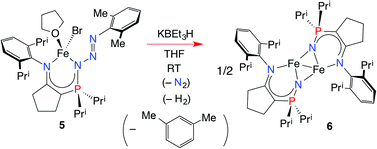Cleavage of an aryl carbon–nitrogen bond of a phosphazido iron(ii) complex promoted by hydride metathesis†
Abstract
Upon reaction with KBEt3H, the pseudo tetrahedral Fe(II) complex 5 with a bulky enamido-phosphazide ligand set undergoes elimination of N2 and 1,3-Me2C6H4 to generate the dinuclear Fe(II) derivative 6 with bridging phosphinimido units. When the reaction is performed using KBEt3D, no deuterium is incorporated into the eliminated 1,3-Me2C6H4; all of the deuterium ends up as D2. When the reaction is performed in THF-d8, only 2-d-1,3-Me2C6H3D was detected by GCMS. These studies are consistent with a radical mechanism.


 Please wait while we load your content...
Please wait while we load your content...